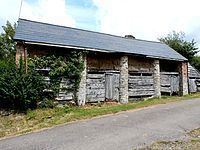 | ||
Atv linhay cerculete
A linhay (pronounced: linny) is a type of farm building found particularly in Devon, south-west England. It is characterised as a two-storied building with an open front, with tallet or hay-loft above and livestock housing below. It often has a lean-to roof, and the front generally consists of regularly spaced pillars or columns. Cattle linhays were used to house cattle in the winter with hay storage above. Due to the wide open front hay was easily thrown up into the tallet by use of a pitch-fork by a man standing on a hay-cart for storage after haymaking operations. The hay was kept dry by the roof and at the same time acted as insulation for the livestock below and was easily fed as daily rations to the cattle below by dropping it through openings in the floor directly into hay racks accessible to the livestock. A cart linhay stored carts and other farm machinery in place of livestock, with hay above. Linhays are now largely obsolete as in England cattle are generally housed in large pole barns with corrugated iron or plastic roofs and are fed silage, either in large round bales or in troughs, chopped up by machinery. These modern structures make possible feeding and mucking-out with large tractors.
Contents
A rare form is the circular linhay, found for example on Braunton Burrows in Devon.
Ltz 400 outlander 800 linhay 260
North America
In Newfoundland English a linney is a storage space, kitchen, or porch generally built as an addition at the rear of a house. In American English a linhay is an open lean-to shed attached to a farm yard.
